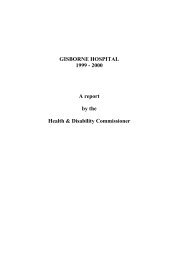09HDC01565 - Health and Disability Commissioner
09HDC01565 - Health and Disability Commissioner
09HDC01565 - Health and Disability Commissioner
You also want an ePaper? Increase the reach of your titles
YUMPU automatically turns print PDFs into web optimized ePapers that Google loves.
<strong>Health</strong> <strong>and</strong> <strong>Disability</strong> <strong>Commissioner</strong><br />
272. All three patients in SCU were due to be checked at 7am. RN Ms K states that the<br />
patient with the highest priority was the patient who had most recently returned from<br />
surgery — the patient in bed space three. When RN Ms K first entered, she observed<br />
that this patient was sleeping <strong>and</strong> she noted that his pulse <strong>and</strong> oxygen saturations were<br />
well within acceptable levels.<br />
273. The curtain had been pulled around Mr A‘s bedspace to prevent the night light shining<br />
in his face. RN Ms J states that throughout her duty, the curtain was drawn but with a<br />
gap such that she was able to see Mr A when she was sitting at the nurses‘ station. RN<br />
Ms K states that when she entered SCU for the first time, the curtain around Mr A<br />
was closed if not fully, then at least to the point that she was unable to see Mr A from<br />
where she was st<strong>and</strong>ing. She states further that although it was not her practice to<br />
allow patients in SCU to have the curtains closed for any length of time, it was not<br />
unusual for this to occur for short periods of time when patients wanted a degree of<br />
privacy.<br />
274. Ms Hewson states that RN Ms K‘s actions on entering SCU were unreasonable. One<br />
patient was ambulatory. One patient was visible, as was his monitor. The third patient,<br />
Mr A, was not visible. Ms Hewson considers RN Ms K should have verified Mr A‘s<br />
condition in the first instance. CDHB also notes that RN Ms K had no reason to be<br />
concerned about Mr A, but acknowledges that she should have sighted all of the<br />
patients in the room before becoming involved in the provision of care. Ms Pirret, the<br />
nursing expert consulted by RN Ms K‘s legal representative, submits that RN Ms K‘s<br />
actions at this time were reasonable on the basis that the information provided at<br />
h<strong>and</strong>over gave no reason to be concerned about Mr A.<br />
275. I appreciate that having been given no information at h<strong>and</strong>over to suggest any cause<br />
for concern about any of the three patients, the highest priority for RN Ms K was the<br />
patient who had most recently returned from surgery. However, I agree with Ms<br />
Hewson <strong>and</strong> CDHB, that RN Ms K should have visually observed all of the patients<br />
in the room before becoming involved in their care. The curtain had been pulled<br />
around Mr A‘s bedspace to prevent him being disturbed by the light. It had apparently<br />
not prevented Mr A from being observed by RN Ms J during her shift, because she<br />
was seated at the nurses‘ desk. RN Ms K was in a different position, <strong>and</strong> the curtain<br />
did prevent her from sighting Mr A. I agree that RN Ms K‘s judgement in this regard<br />
was poor, but in my view, this must be seen in the context of the concerns I have<br />
previously outlined in relation to the functioning of the SCU at this time, <strong>and</strong> the<br />
h<strong>and</strong>over advice that Mr A was stable.<br />
276. I note also RN Ms K‘s actions on finding Mr A unresponsive. She explains that her<br />
first instinct was to go back to what she had been taught for years, namely the ABC<br />
resuscitation process. She states that she is fully aware that the new guidelines<br />
emphasise cardiac compressions over artificial respirations. I accept RN Hewson‘s<br />
advice that it is underst<strong>and</strong>able that RN Ms K reverted to previous practice in this<br />
stressful situation. Once she saw Mr A, RN Ms K raised the alarm immediately <strong>and</strong><br />
help arrived promptly.<br />
5 September 2012 46<br />
Names have been removed (except Canterbury DHB <strong>and</strong> the experts who advised on this case) to<br />
protect privacy. Identifying letters are assigned in alphabetical order <strong>and</strong> bear no relationship to the<br />
person’s actual name.
















